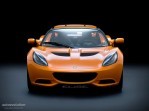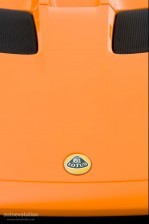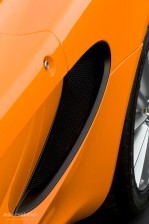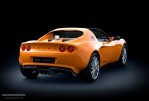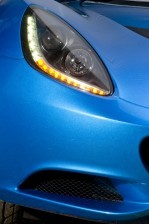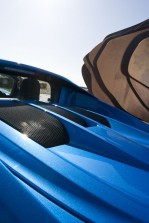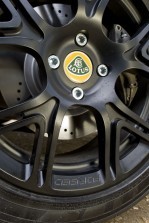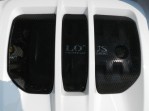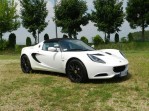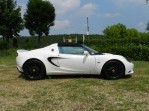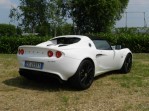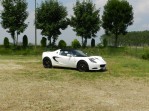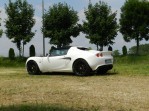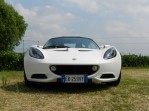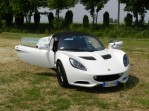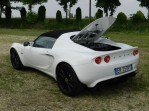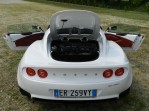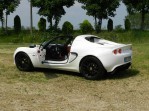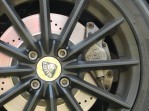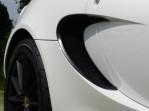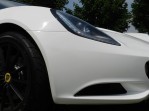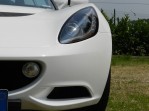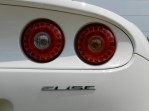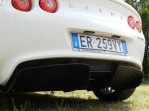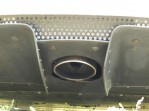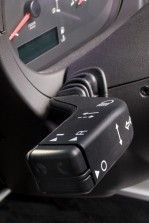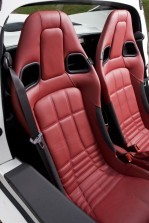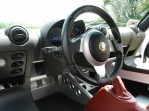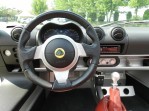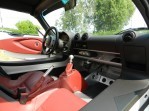Body style: Convertible (spider/spyder, cabrio/cabriolet, drop/open/soft top)
Segment: Exotic
Production years: 2010, 2011, 2012, 2013, 2014, 2015, 2016, 2017, 2018, 2019, 2020, 2021
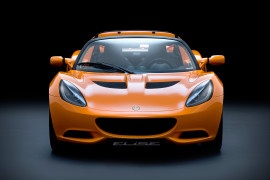 61 Photos
61 PhotosLotus introduced the Series 3 for the Elise in 2010, a decade after launching the Series 2 into production, and it was mostly a refreshed version rather than a new model.
Lotus, like many other niche automakers, suffered during the world financial crisis. Still, the Elise was selling well; some might say it didn’t need improvement. But Lotus thought differently. Since the Euro 5 emission standards were due to enter in January 2011, the British automaker considered refreshing the Series 2, which it launched at the beginning of 2010. Besides some aesthetic changes, the lightweight sportscar also had new engines under its hood and an updated cabin for daily driving.
One of the most obvious changes of the Series 3 over the Series 2 was noticed up front. The 2010 model came with snake-like-shaped headlights. They integrated the LED daytime running lights, which doubled as turn signals, underlining the headlamps. As a result, the blinkers from the upper side of the bumper were deleted. In the apron, the automaker installed the main air intake shaped like a smile. As an option, customers could order the car with a pair of fog lamps, which flanked the grille. Lower, on the sides, Lotus added a pair of scoops that cooled the front rotors.
A keen eye for detail could notice the differences between a Series 2 and a Series 3, the most evident being in the air intakes placed on the rear quarter panels. While on the S2 Elise, the automaker added five horizontal fins that streamlined the airflow, on the S3, those aerodynamic elements were deleted. In addition, Lotus offered a new design for the wheels and even a lightweight set that shaved 2.14 kilos (4.7 lbs.) compared to the standard ones. But still, no major aesthetic changes were made for the best-selling Lotus to that date since the Elise, in its 14 years of production, accounted for 32% of all Lotus cars manufactured since 1948.
Customers asked Lotus to create lightweight cars, but not with a scarce interior. As a result, the automaker offered a base version that featured nothing but a steering wheel, dual airbag, and a ventilation system, while buyers could opt for additional items. They could have the car fitted with an air conditioning system, a leather-wrapped interior, and a factory-installed, off-the-shelf stereo. Power steering was still unavailable, but power windows, yes. There were fewer aluminum elements left exposed in the cockpit, and that delighted customers. But there was a price for these added amenities: the weight.
Behind the cockpit, Lotus introduced a range of Euro 5 compatible engines. Surprisingly, the car manufacturer installed an even smaller displacement powerplant carried over from Toyota. If U.S. customers could have the Elise S3 in basic specification fitted with a 1.8-liter, Europeans and other buyers could get it with a 1.6-liter naturally aspirated powerplant. At least both of them featured the same six-speed manual gearbox also provided by Toyota but with Lotus’ specifications. The car came standard with a track-tuned ABS.
LOTUS Elise 2010, 2011, 2012, 2013, 2014, 2015, 2016, 2017, 2018, 2019, 2020, 2021
- 1.6L S 6MT RWD (134 HP)
- 1.8L R 6MT RWD (192 HP)
- 1.8L SC 6AT RWD (217 HP)
LOTUS Elise
1.6L S 6MT RWD (134 HP)
ENGINE SPECS - 1.6L S 6MT RWD (134 HP) | |
|---|---|
| Cylinders: | L4 |
| Displacement: | 1598 cm3 |
| Power: | 100 KW @ 6800 RPM 134 HP @ 6800 RPM 134 BHP @ 6800 RPM |
| Torque: | 118 lb-ft @ 4400 RPM 160 Nm @ 4400 RPM |
| Fuel System: | Turbocharged multipoint injection |
| Fuel: | Gasoline |
PERFORMANCE SPECS | |
|---|---|
| Top Speed: | 127 mph (204 km/h) |
| Acceleration 0-62 Mph (0-100 kph): | 6.5 s |
TRANSMISSION SPECS | |
|---|---|
| Drive Type: | Rear Wheel Drive |
| Gearbox: | 6-speed manual |
BRAKES SPECS | |
|---|---|
| Front: | Ventilated Discs |
| Rear: | Discs |
TIRES SPECS | |
|---|---|
| Tire Size: | 175/55 R16 front and 225/45 R17 rear |
DIMENSIONS | |
|---|---|
| Length: | 149 in (3785 mm) |
| Width: | 67.7 in (1720 mm) |
| Height: | 44 in (1118 mm) |
| Front/rear Track: | 57.3/59.3 in (1,455/1,506 mm) |
| Wheelbase: | 90.5 in (2299 mm) |
| Ground Clearance: | 5.1 in (130 mm) |
| Cargo Volume: | 3.9 cuFT (110 L) |
| Aerodynamics (Cd): | 0.4 |
WEIGHT SPECS | |
|---|---|
| Unladen Weight: | 1918 lbs (870 kg) |
| Gross Weight Limit: | 2571 lbs (1166 kg) |
FUEL ECONOMY (NEDC) | |
|---|---|
| City: | 28.3 mpg US (8.3 L/100Km) |
| Highway: | 47 mpg US (5 L/100Km) |
| Combined: | 37.3 mpg US (6.3 L/100Km) |
| CO2 Emissions: | 149 g/km |
LOTUS Elise
1.8L R 6MT RWD (192 HP)
ENGINE SPECS - 1.8L R 6MT RWD (192 HP) | |
|---|---|
| Cylinders: | L4 |
| Displacement: | 1796 cm3 |
| Power: | 141 KW @ 7800 RPM 192 HP @ 7800 RPM 189 BHP @ 7800 RPM |
| Torque: | 133 lb-ft @ 6800 RPM 180 Nm @ 6800 RPM |
| Fuel System: | Turbocharged multipoint injection |
| Fuel: | Gasoline |
PERFORMANCE SPECS | |
|---|---|
| Top Speed: | 150 mph (241 km/h) |
| Acceleration 0-62 Mph (0-100 kph): | 5.4 s |
TRANSMISSION SPECS | |
|---|---|
| Drive Type: | Rear Wheel Drive |
| Gearbox: | 6-speed manual |
BRAKES SPECS | |
|---|---|
| Front: | Ventilated Discs |
| Rear: | Discs |
TIRES SPECS | |
|---|---|
| Tire Size: | 175/55 R16 front and 225/45 R17 rear |
DIMENSIONS | |
|---|---|
| Length: | 149 in (3785 mm) |
| Width: | 67.7 in (1720 mm) |
| Height: | 44 in (1118 mm) |
| Front/rear Track: | 57.3/59.3 in (1,455/1,506 mm) |
| Wheelbase: | 90.5 in (2299 mm) |
| Ground Clearance: | 5.1 in (130 mm) |
| Cargo Volume: | 3.9 cuFT (110 L) |
| Aerodynamics (Cd): | 0.4 |
WEIGHT SPECS | |
|---|---|
| Unladen Weight: | 1918 lbs (870 kg) |
| Gross Weight Limit: | 2571 lbs (1166 kg) |
FUEL ECONOMY (NEDC) | |
|---|---|
| City: | 20.3 mpg US (11.6 L/100Km) |
| Highway: | 37.9 mpg US (6.2 L/100Km) |
| Combined: | 28.7 mpg US (8.2 L/100Km) |
| CO2 Emissions: | 196 g/km |
LOTUS Elise
1.8L SC 6AT RWD (217 HP)
ENGINE SPECS - 1.8L SC 6AT RWD (217 HP) | |
|---|---|
| Cylinders: | L4 |
| Displacement: | 1796 cm3 |
| Power: | 163 KW @ 8000 RPM 217 HP @ 8000 RPM 219 BHP @ 8000 RPM |
| Torque: | 156 lb-ft @ 5000 RPM 212 Nm @ 5000 RPM |
| Fuel System: | Turbocharged multipoint injection |
| Fuel: | Gasoline |
PERFORMANCE SPECS | |
|---|---|
| Top Speed: | 145 mph (233 km/h) |
| Acceleration 0-62 Mph (0-100 kph): | 4.6 s |
TRANSMISSION SPECS | |
|---|---|
| Drive Type: | Rear Wheel Drive |
| Gearbox: | 6-speed automatic |
BRAKES SPECS | |
|---|---|
| Front: | Ventilated Discs |
| Rear: | Discs |
TIRES SPECS | |
|---|---|
| Tire Size: | 175/55 R16 front and 225/45 R17 rear |
DIMENSIONS | |
|---|---|
| Length: | 149 in (3785 mm) |
| Width: | 67.7 in (1720 mm) |
| Height: | 44 in (1118 mm) |
| Front/rear Track: | 57.3/59.3 in (1,455/1,506 mm) |
| Wheelbase: | 90.5 in (2299 mm) |
| Ground Clearance: | 5.1 in (130 mm) |
| Cargo Volume: | 3.9 cuFT (110 L) |
| Aerodynamics (Cd): | 0.4 |
WEIGHT SPECS | |
|---|---|
| Unladen Weight: | 1918 lbs (870 kg) |
| Gross Weight Limit: | 2571 lbs (1166 kg) |
FUEL ECONOMY (NEDC) | |
|---|---|
| City: | 19.9 mpg US (11.8 L/100Km) |
| Highway: | 36.7 mpg US (6.4 L/100Km) |
| Combined: | 27.7 mpg US (8.5 L/100Km) |
| CO2 Emissions: | 202 g/km |
